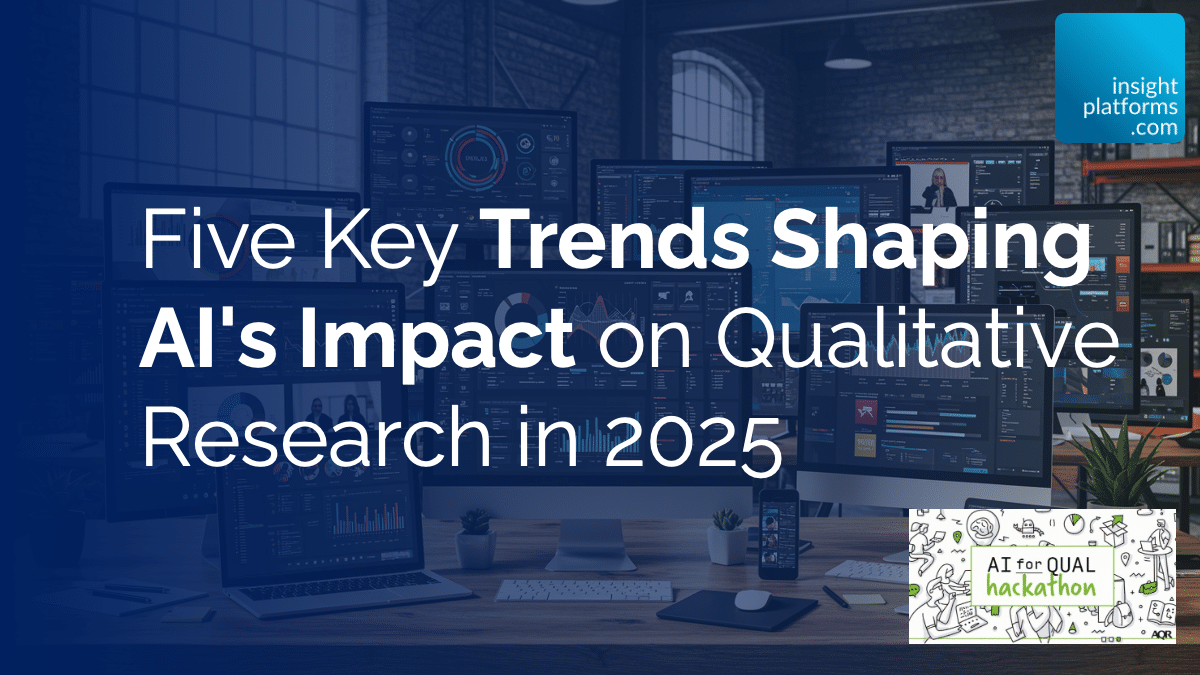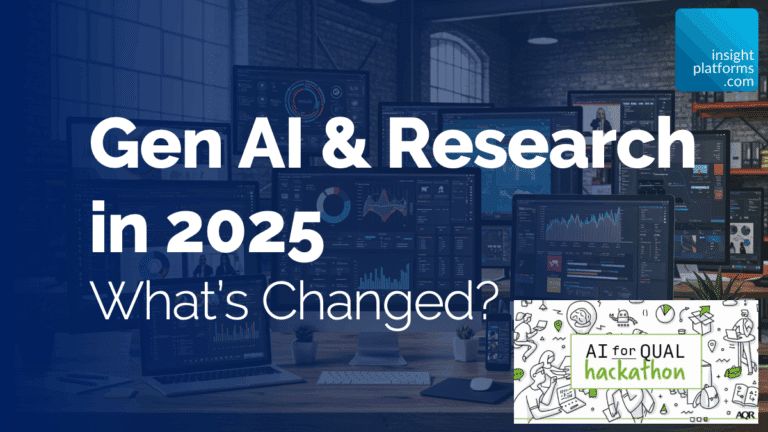
Five Key Trends Shaping AI’s Impact on Qualitative Research in 2025
By Insight Platforms
- article
- Qualitative Research
- AI
- Market Trends
The pace of change in generative AI is showing no signs of slowing down, and qualitative research is right in the thick of it. Drawing on a recent AQR Hackathon session, here are five trends shaping how researchers are working with AI this year.
Watch the replay of the webinar:
AQR Hackathon – AI for Qual – Gen AI for Market Research in 2025
Stay up to date
Subscribe to receive the Research Tools Radar and essential email updates from Insight Platforms.
Your email subscriptions are subject to the Insight Platforms Site Terms and Privacy Policy.
1. Deeper Empathy
AI is getting better at reading the room. Thanks to advances in affective computing, some tools now combine voice, vision, and text to create more empathetic research interactions. But it’s not only about research, Harvard Business Review recently highlighted how therapy and companionship have become leading use cases for generative AI. This demonstrates the technology’s growing ability to engage in emotionally intelligent exchanges, which matters when asking participants to open up.
Voice AI from companies like ElevenLabs is pushing this forward with human-sounding delivery and nuance. As multimodal models mature—combining text, voice, and visual inputs—their emotional intelligence increases. People already humanise technology, so the more lifelike the AI, the more naturally participants will engage.
2. Enhanced Interaction
Conversational AI is changing the way researchers interact with participants and stakeholders. Chatbot-led interviews, adaptive surveys, and voice-based inputs are all helping bridge the gap between qualitative depth and quantitative scale.
Platforms like BoltChat AI allow real-time interviews that adapt as conversation unfolds. Inca is adding structured rigour to verbatim. Tellet is experimenting with voice feedback, transcribed instantly, and fed back into the dialogue. Experimental platforms like GetWhy’s Bloom use video avatars to conduct interviews in real-time.
On the output side, we are seeing client deliverables become more dynamic. AI Bods and Verve use conversational AI to synthesise research inputs into interactive avatars that clients can engage with directly. This is a clear shift towards interactive research outputs.
3. Increased Autonomy
Deep research capabilities in tools like ChatGPT enable automated desk research and synthesis. These can autonomously conduct research, question their own findings through chain-of-thought processes, and prepare comprehensive reports.
Zappi has developed concept creation agents that function as virtual marketing teams, taking consumer insights through concept generation and testing processes. Verve combines deep research with autonomous workflows that generate insights from social media, industry news, and competitor activity. Fuel Cycle is pioneering autonomous insights approaches for large-scale communities. Focaldata’s AI co-worker manages end-to-end research processes from brief development to reporting. And platforms like Metaforms are enabling small agencies to access these capabilities.
4. Tighter Integration
Leading insights teams focus on building integrated knowledge assets rather than siloed research projects.
Zappi delivers data as continuous streams that build value over time within client organisations. Delineate demonstrates this through its work with global brands like Coca-Cola, piping daily advertising effectiveness and brand tracking data directly into client data lakes. Brainsuite integrates AI and neuroscience-based insights with marketing systems for optimised media mix modelling.
Knowledge management platforms like Market Logic’s Deep Sites Assistant connect insights across multiple business tools and departments, making research accessible through conversational AI interfaces in Slack or Teams. Video repositories are increasingly becoming sources of metadata learning, helping build understanding over time.
5. More Personality
Recent research has highlighted concerns about AI’s potential to flatten insights toward averages, termed “knowledge collapse”. However, evidence suggests creative use of AI can actually increase diversity in ideation and outputs.
The key for qualitative researchers is to identify their unique expertise and use AI to enhance it. This could include training AI interviewers on a researcher’s discussion guides, using cloned voices for interviews, or creating virtual versions of expertise using GPT models.
For independent researchers and small agencies, these tools represent an opportunity to scale impact while maintaining distinctive approaches. AI agents can increase efficiency in process management while preserving the researcher’s unique perspective and methodology.
Looking Ahead
These trends indicate that AI isn’t here to replace the human element in qualitative research, and instead is here to augment it. With a thoughtful approach, researchers can use these tools to go deeper, work faster, and deliver more impactful insights, without losing their unique perspective.
For qualitative researchers and small agencies, this may represent an unprecedented opportunity to scale impact through the creative application of AI tools. The combination of deeper empathy, enhanced interaction, increased autonomy, tighter integration, and more personality suggests a future where AI enhances human insight.
Note: This blog post was created using content from an AQR Hackathon presentation in April 2025. Watch it on demand below.


